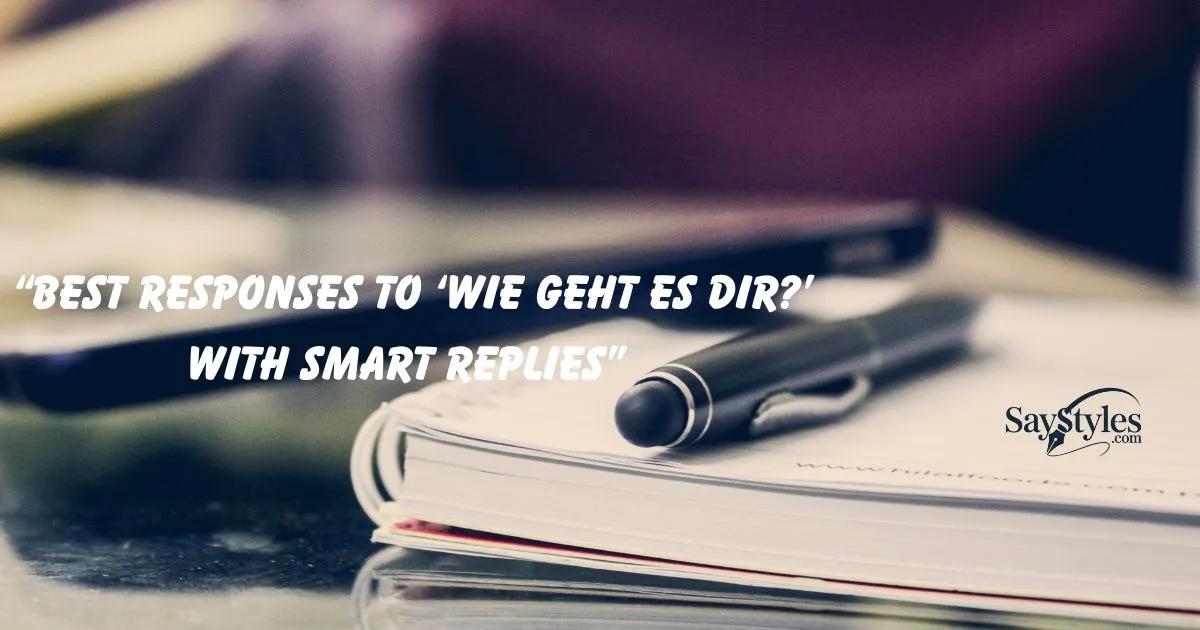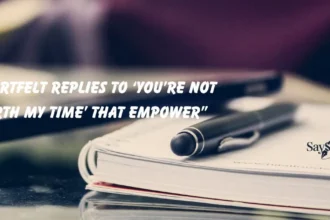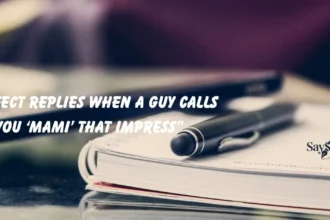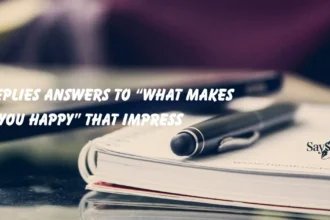“How to Respond to Wie geht es dir?” is a question that opens doors to connection. When someone asks you “Wie geht es dir?”, they are really asking how you are feeling. I often notice many people pause, unsure how to answer. Don’t worry I’m here to guide you through easy and natural ways to respond.
Talking about feelings doesn’t have to be complicated. You can keep your answer simple, polite, and friendly. In this article, I will share clear examples, tips, and phrases you can use anytime someone asks “Wie geht es dir?”. Whether you want a casual answer or a more detailed one, you will find something that fits perfectly.
By the end of this article, you will know exactly how to respond to “Wie geht es dir?” in a way that feels natural, confident, and human. Every tip in this guide is written in simple English so anyone can understand and use it.
1. “Mir geht’s gut, und dir?”
Story: Anna replied this to her friend Lukas after he asked how she was doing in the morning chat.
When to Use: Perfect for casual greetings with friends or colleagues.
When Not to Use: Avoid in formal situations with strangers or professional emails.
Example:
Lukas: “Hallo Anna!” “Wie geht’s?”
Anna: “Mir geht’s gut, und dir?”
How to Respond 🗣️ A reply could be, “Mir auch, danke!” or “Alles bestens bei mir.”
2. “Alles bestens!” “Und du?”
Story: Felix used this when greeting his coworker Marie during a quick chat break.
When to Use: Great for friendly or professional casual interactions.
When Not to Use: Avoid if you want to show deep concern or empathy.
Example:
Marie: “Hey Felix, wie läuft’s?”
Felix: “Alles bestens!” “Und du?”
How to Respond 🗣️ They could reply, “Super, danke!” or “Alles gut hier.”
3. “Sehr gut, danke!”
Story: Laura answered her classmate Jonas after he asked about her day.
When to Use: Best when you feel genuinely good and want a short positive reply.
When Not to Use: Avoid if you want to elaborate or discuss your problems.
Example:
Jonas: “Wie geht’s dir heute?”
Laura: “Sehr gut, danke!”
How to Respond 🗣️ They could say, “Freut mich!” or “Schön zu hören.”
4. “Nicht schlecht, und selbst?”
Story: Tim texted this to his friend Sarah after a casual check-in.
When to Use: Ideal for friendly conversations where you’re doing okay.
When Not to Use: Avoid if you want to sound extremely enthusiastic or formal.
Example:
Sarah: “Wie geht’s dir?”
Tim: “Nicht schlecht, und selbst?”
How to Respond 🗣️ They could reply, “Auch gut, danke!” or “Ganz gut, und bei dir?”
5. “Mir geht’s super!”
Story: Julia replied to her brother Max after he asked about her weekend.
When to Use: Use when you feel excellent and want to sound positive.
When Not to Use: Avoid if the mood is serious or sad.
Example:
Max: “Na Julia, wie war dein Tag?”
Julia: “Mir geht’s super!”
How to Respond 🗣️ They could say, “Freut mich zu hören!” or “Das ist toll!”
6. “Alles prima!”
Story: Leon answered his friend Nina after she asked casually about his day.
When to Use: Best for casual, upbeat chats with friends.
When Not to Use: Avoid in formal or serious situations.
Example:
Nina: “Hey Leon, alles klar?”
Leon: “Alles prima!”
How to Respond 🗣️ They could reply, “Schön!” or “Super!”
7. “Fantastisch, danke!”
Story: Sophie sent this to her colleague Daniel after a morning greeting.
When to Use: Ideal when you want to sound cheerful and positive.
When Not to Use: Avoid if you are having a rough day.
Example:
Daniel: “Guten Morgen, Sophie!” “Wie geht’s?”
Sophie: “Fantastisch, danke!”
How to Respond 🗣️ They could reply, “Freut mich zu hören!” or “Klasse!”
8. “Top, wie läuft’s?”
Story: Jonas messaged this to his friend Lisa during a lunch break chat.
When to Use: Perfect for informal conversations with friends.
When Not to Use: Avoid formal professional emails.
Example:
Lisa: “Hey Jonas, was geht?”
Jonas: “Top, wie läuft’s?”
How to Respond 🗣️ They could reply, “Alles gut!” or “Läuft prima.”
See also: “Best Responses to Rude Customers Smart & Calm Comebacks”
9. “Ein bisschen müde, du?”
Story: Mia replied to her friend Felix after a long day at work.
When to Use: Best for casual check-ins when you’re honest about your mood.
When Not to Use: Avoid if you want to sound fully energetic.
Example:
Felix: “Na Mia, wie geht’s?”
Mia: “Ein bisschen müde, du?”
How to Respond 🗣️ They could say, “Auch ein bisschen müde” or “Ich auch, haha.”
10. “Mir geht’s okay.”

Story: Paul answered his friend Sarah during a midweek chat.
When to Use: Use when you feel neutral and want to keep the conversation light.
When Not to Use: Avoid if someone is asking about serious emotional support.
Example:
Sarah: “Wie war dein Tag?”
Paul: “Mir geht’s okay.”
How to Respond 🗣️ They could reply, “Alles klar” or “Gut zu wissen.”
11. “I hear you, and I’ll do my best to assist you.”
Story: Daniel replied this when his client Ava expressed concern about a missing invoice.
When to Use: Perfect for showing empathy and willingness to help.
When Not to Use: Avoid if you cannot provide any assistance.
Example:
Ava: “I can’t find the invoice for last month.”
Daniel: “I hear you, and I’ll do my best to assist you.”
How to Respond 🗣️ They could say, “Thank you, I appreciate it,” or “That helps a lot!”
12. “I’m sorry if this caused any trouble. Let’s find a solution.”
Story: Maria said this after a client Liam reported a technical glitch in a service.
When to Use: Best when apologizing and immediately moving to resolve the issue.
When Not to Use: Avoid if the issue hasn’t affected the other person.
Example:
Liam: “The app logged me out unexpectedly.”
Maria: “I’m sorry if this caused any trouble. Let’s find a solution.”
How to Respond 🗣️ They could reply, “Thanks, let’s fix it,” or “I appreciate your help.”
13. “Let’s see how we can correct this issue quickly.”
Story: Ethan used this when a colleague reported missing data in a report.
When to Use: Perfect for showing urgency and problem-solving.
When Not to Use: Avoid if speed is not relevant or necessary.
Example:
Colleague: “Some data is missing from the report.”
Ethan: “Let’s see how we can correct this issue quickly.”
How to Respond 🗣️ They could say, “Great, let’s do it,” or “Thanks for acting fast.”
14. “Thank you for your honesty. Let’s work on a resolution.”
Story: Sophia replied this when a customer reported an error in a product review.
When to Use: Ideal for handling feedback professionally and positively.
When Not to Use: Avoid if no feedback or honesty was given.
Example:
Customer: “The product didn’t meet my expectations.”
Sophia: “Thank you for your honesty. Let’s work on a resolution.”
How to Respond 🗣️ They could reply, “Appreciate it,” or “Glad we can fix it.”
15. “I apologize for any misunderstanding.”
Story: Liam sent this after a teammate was confused about project instructions.
When to Use: Best when acknowledging confusion or miscommunication.
When Not to Use: Avoid if no misunderstanding occurred.
Example:
Teammate: “I thought we were supposed to submit today.”
Liam: “I apologize for any misunderstanding.”
How to Respond 🗣️ They could say, “Thanks for clarifying,” or “No worries, let’s move forward.”
16. “I understand your concerns. Here’s what I can do.”
Story: Chloe said this when a client complained about service delays.
When to Use: Perfect for providing reassurance and a solution.
When Not to Use: Avoid if you have no solution to offer.
Example:
Client: “I’m concerned about my order being late.”
Chloe: “I understand your concerns. Here’s what I can do.”
How to Respond 🗣️ They could reply, “Thank you for helping,” or “That works for me.”
17. “Let’s focus on what we can do to resolve this together.”
Story: Ethan used this when a colleague reported a technical issue.
When to Use: Ideal for collaborative problem-solving.
When Not to Use: Avoid if the person doesn’t want help or collaboration.
Example:
Colleague: “I can’t get this tool to work.”
Ethan: “Let’s focus on what we can do to resolve this together.”
How to Respond 🗣️ They could say, “Sounds good, let’s fix it,” or “I appreciate your support.”
18. “I’m listening. Let’s find a way to fix this.”
Story: Maria said this when a client complained about missing features in software.
When to Use: Best for showing attentiveness and readiness to act.
When Not to Use: Avoid if the issue doesn’t require a solution.
Example:
Client: “I can’t access the new update properly.”
Maria: “I’m listening. Let’s find a way to fix this.”
How to Respond 🗣️ They could reply, “Thanks, I appreciate your help,” or “Great, let’s work on it.”
19. “I appreciate your patience as we sort this out.”
Story: Liam used this while handling a delayed delivery complaint.
When to Use: Perfect when asking for patience during a process.
When Not to Use: Avoid if no delay exists.
Example:
Customer: “It’s been a long wait for my package.”
Liam: “I appreciate your patience as we sort this out.”
How to Respond 🗣️ They could say, “Thanks for acknowledging it,” or “I’ll wait for the update.”
20. “I hear your concerns. Let’s move forward with a solution.”
Story: Chloe used this when a client reported an error in billing.
When to Use: Great for acknowledging concerns while emphasizing solutions.
When Not to Use: Avoid if no concerns exist.
Example:
Client: “This bill doesn’t look correct.”
Chloe: “I hear your concerns. Let’s move forward with a solution.”
How to Respond 🗣️ They could reply, “Thank you, I appreciate that,” or “Let’s fix it.”
See also: Best Happy Friendship Day Replies to Make Friends Smile
21. “I apologize for any inconvenience caused.”
Story: Daniel sent this after a shipping delay affected a customer’s order.
When to Use: Ideal for professional apology situations.
When Not to Use: Avoid if no inconvenience occurred.
Example:
Customer: “My order hasn’t arrived yet.”
Daniel: “I apologize for any inconvenience caused.”
How to Respond 🗣️ They could say, “Thanks for acknowledging,” or “I appreciate the apology.”
22. “Thank you for letting me know. Let’s address it immediately.”
Story: Sophia replied this when a client reported a website error.
When to Use: Perfect for showing urgency and appreciation.
When Not to Use: Avoid if the issue is minor or irrelevant.
Example:
Client: “There’s a broken link on your site.”
Sophia: “Thank you for letting me know. Let’s address it immediately.”
How to Respond 🗣️ They could reply, “Thanks, I appreciate the quick action,” or “Great, let’s fix it.”
23. “I understand this situation isn’t ideal. Let’s improve it.”
Story: Liam said this when a client received a damaged product.
When to Use: Best for showing empathy and offering improvement.
When Not to Use: Avoid if no problem exists.
Example:
Client: “The package arrived damaged.”
Liam: “I understand this situation isn’t ideal. Let’s improve it.”
How to Respond 🗣️ They could say, “Thanks, let’s fix it,” or “Appreciate your help.”
24. “I’m committed to helping you today.”
Story: Emma used this when a customer needed urgent assistance.
When to Use: Perfect for emphasizing dedication.
When Not to Use: Avoid if the situation is casual or not urgent.
Example:
Customer: “I need this resolved quickly.”
Emma: “I’m committed to helping you today.”
How to Respond 🗣️ They could reply, “Thank you, I appreciate that,” or “Glad to have your help.”
25. “I appreciate your feedback and will ensure it’s addressed.”
Story: Chloe said this when a client gave suggestions for improvement.
When to Use: Great for showing that feedback matters.
When Not to Use: Avoid if the feedback isn’t actionable.
Example:
Client: “The interface could be easier to navigate.”
Chloe: “I appreciate your feedback and will ensure it’s addressed.”
How to Respond 🗣️ They could reply, “Thanks for listening,” or “Glad it’s being considered.”
26. “I’m sorry for the trouble. Let’s find the best solution.”
Story: Daniel used this when a client reported a repeated software glitch.
When to Use: Best for apologizing and offering resolution.
When Not to Use: Avoid if no trouble occurred.
Example:
Client: “The glitch keeps happening.”
Daniel: “I’m sorry for the trouble. Let’s find the best solution.”
How to Respond 🗣️ They could say, “Thanks, I appreciate your help,” or “Let’s resolve it.”
27. “I hear your frustration. Here’s how we can help.”
Story: Sophia said this when a client expressed anger over a service delay.
When to Use: Perfect for acknowledging strong feelings and providing solutions.
When Not to Use: Avoid if the person is calm or neutral.
Example:
Client: “I’m so frustrated with this delay!”
Sophia: “I hear your frustration. Here’s how we can help.”
How to Respond 🗣️ They could reply, “Thank you, that helps,” or “I appreciate your support.”
Absolutely! Here’s 28–35 expanded in the same H2 style with Story, When to Use, When Not to Use, Example, and How to Respond 🗣️:
28. “I apologize and want to make this right for you.”
Story: Liam said this to his client Mia after a mistake in her order caused frustration.
When to Use: Perfect when you need to show accountability and commitment to fixing an issue.
When Not to Use: Avoid if the problem wasn’t your responsibility or didn’t affect the person.
Example:
Mia: “My order is wrong again!”
Liam: “I apologize and want to make this right for you.”
How to Respond 🗣️ They could reply, “Thank you, I appreciate it,” or “I’m glad you’re addressing this.”
29. “I understand, and I’ll do everything I can to assist.”
Story: Emma sent this when her colleague Noah faced a technical problem with shared software.
When to Use: Best for serious issues where you want to reassure full support.
When Not to Use: Avoid if it’s a minor situation that doesn’t require full attention.
Example:
Noah: “I can’t access the system!”
Emma: “I understand, and I’ll do everything I can to assist.”
How to Respond 🗣️ They could say, “Thanks, that’s helpful,” or “Appreciate your help.”
30. “Thank you for your patience. Let’s fix this together.”
Story: Olivia replied this after a client Chris waited for a delayed service update.
When to Use: Ideal for collaborative problem-solving while recognizing patience.
When Not to Use: Avoid if no delay or wait was involved.
Example:
Chris: “It’s been a while, any updates?”
Olivia: “Thank you for your patience. Let’s fix this together.”
How to Respond 🗣️ They could reply, “Thanks, I’m ready to help,” or “Appreciate it, let’s do it.”
31. “I’m listening carefully. Let’s solve this issue.”

Story: Daniel said this when his teammate Ava explained a complex workflow problem.
When to Use: Perfect for showing attentiveness before taking action.
When Not to Use: Avoid if the issue is very minor and doesn’t need detailed attention.
Example:
Ava: “The system keeps crashing when I log in.”
Daniel: “I’m listening carefully. Let’s solve this issue.”
How to Respond 🗣️ They could reply, “Thanks, glad you’re on it,” or “I appreciate your focus.”
32. “I hear you, and I appreciate your feedback.”
Story: Sophia sent this after a customer reported that a product feature was confusing.
When to Use: Great for showing acknowledgment and appreciation for constructive criticism.
When Not to Use: Avoid if the feedback isn’t relevant or actionable.
Example:
Customer: “The new app update is confusing.”
Sophia: “I hear you, and I appreciate your feedback.”
How to Respond 🗣️ They could reply, “Thanks for listening,” or “Glad you value my input.”
33. “I understand your point. Let’s work on a resolution.”
Story: Liam said this when his client Chloe pointed out a billing error.
When to Use: Ideal for professional situations requiring a solution.
When Not to Use: Avoid if the point made isn’t valid or relevant.
Example:
Chloe: “I was charged incorrectly on my last invoice.”
Liam: “I understand your point. Let’s work on a resolution.”
How to Respond 🗣️ They could reply, “Thank you, let’s fix it,” or “I appreciate the support.”
See also: “Best Responses for Happy Teacher Appreciation Week Wishes”
34. “I apologize for any stress this has caused.”
Story: Emma said this when her team delayed responding to a client’s urgent email.
When to Use: Perfect for acknowledging emotional impact while keeping professional tone.
When Not to Use: Avoid if no stress was caused or the issue is minor.
Example:
Client: “I needed this update yesterday.”
Emma: “I apologize for any stress this has caused.”
How to Respond 🗣️ They could reply, “Thanks for acknowledging it,” or “I appreciate your concern.”
35. “I’m here to support you and find a solution promptly.”
Story: Daniel replied this to his colleague Mia after she reported a technical issue affecting her work.
When to Use: Great for assuring active support and quick resolution.
When Not to Use: Avoid if the situation is not urgent or doesn’t require immediate help.
Example:
Mia: “I can’t access my files!”
Daniel: “I’m here to support you and find a solution promptly.”
How to Respond 🗣️ They could reply, “Thanks, that means a lot,” or “Glad you’re handling this quickly.”
Top 15 Editors’ Choice Responses
- Mir geht’s gut, danke! Und dir? – I’m good, thanks! And you?
- Alles bestens, danke der Nachfrage. – Everything’s great, thanks for asking.
- Nicht schlecht, und selbst? – Not bad, how about yourself?
- Mir geht es hervorragend, danke! – I’m doing excellent, thank you!
- So lala, könnte besser sein. – So-so, could be better.
- Fantastisch, danke! – Fantastic, thanks!
- Alles in Ordnung, und bei dir? – Everything’s fine, and you?
- Mir geht es okay, danke der Nachfrage. – I’m okay, thanks for asking.
- Sehr gut, und wie läuft’s bei dir? – Very good, and how’s it going for you?
- Ich kann nicht klagen, danke. – I can’t complain, thank you.
- Mir geht es wunderbar, danke! – I’m wonderful, thanks!
- Besser, seitdem du gefragt hast! – Better now that you asked! (fun/flirty option)
- Nicht so gut heute, ehrlich gesagt. – Not so good today, to be honest.
- Alles prima, danke. – Everything’s great, thanks.
- Mir geht’s super, danke! – I’m doing awesome, thanks!
Conclusion
Responding to “Wie geht es dir?” doesn’t have to be complicated. You can choose a friendly, casual, or even humorous approach depending on the context.
Remember, adding a follow-up question like “Und dir?” keeps the conversation flowing naturally. With these top responses, you’ll always know how to answer confidently in German and make your interactions smooth and engaging.

I’m Lily Hart, the Admin behind the engaging responses at SayStyles.com! With a knack for blending wit and warmth, I turn every piece of writing into something memorable. From clever advice to fun comebacks, I’m here to make sure every response leaves you smiling and thinking.






